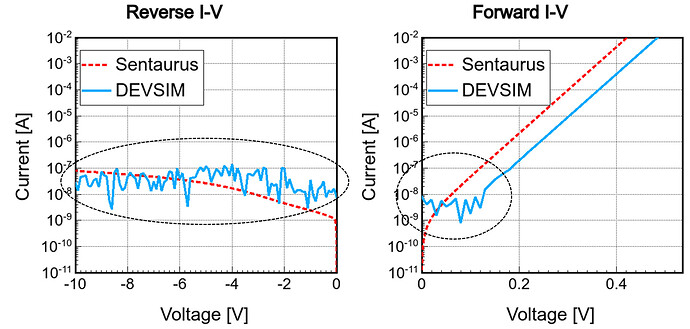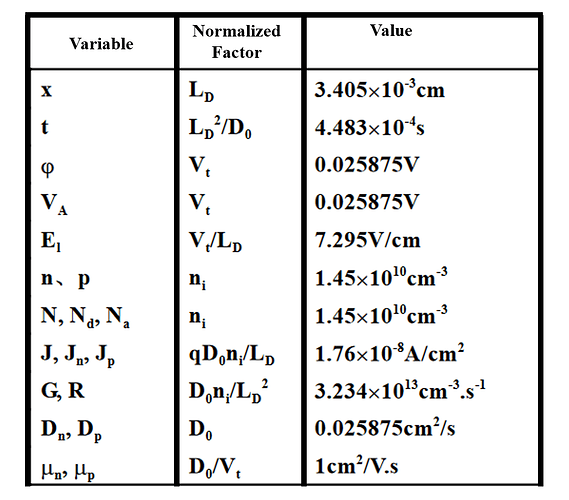Dear DEVSIM developer,
I want to simulate the leakage current of a diode under reverse voltage. But I find there are large fluctuations especially when the leakage current <10^{8} A (see attached figure), I think it may be dominated by the definition of “error” in solve().
How to simulate the leakage current with higher accuracy?
my script is pasted below:
##############################################################################################################################
# diode_1d.py
##############################################################################################################################
import matplotlib
import matplotlib.pyplot
import math
import csv
device="MyDevice"
region="MyRegion"
CreateMesh(device=device, region=region)
SetParameters(device=device, region=region)
devsim.set_parameter(device=device, region=region, name="taun", value=1e-5)
devsim.set_parameter(device=device, region=region, name="taup", value=1e-5)
SetNetDoping(device=device, region=region)
devsim.print_node_values(device=device, region=region, name="NetDoping")
InitialSolution(device, region)
# Initial DC solution
devsim.solve(type="dc", absolute_error=1.0, relative_error=1e-10, maximum_iterations=30)
DriftDiffusionInitialSolution(device, region)
###
### Drift diffusion simulation at equilibrium
###
devsim.solve(type="dc", absolute_error=1e8, relative_error=1e-10, maximum_iterations=30)
fig1=matplotlib.pyplot.figure(num=1,figsize=(4,4))
x=devsim.get_node_model_values(device=device, region=region, name="x")
fields = ("Electrons", "Holes", "Donors", "Acceptors")
for i in fields:
y=devsim.get_node_model_values(device=device, region=region, name=i)
matplotlib.pyplot.semilogy(x, y)
matplotlib.pyplot.xlabel('x (cm)')
matplotlib.pyplot.ylabel('Density (#/cm^3)')
matplotlib.pyplot.legend(fields)
matplotlib.pyplot.savefig("diode_1d_example_density.png")
####
#### Ramp the bias to forward
####
forward_v = 0.0
forward_voltage = []
forward_top_current = []
forward_bot_current = []
forward_voltage.append(0.)
forward_top_current.append(0.)
f1 = open("diode_1d_example_Forward_IV.csv", "w")
header = ["Voltage","Current"]
writer1 = csv.writer(f1)
writer1.writerow(header)
while forward_v < 0.51:
devsim.set_parameter(device=device, name=GetContactBiasName("top"), value=forward_v)
devsim.solve(type="dc", absolute_error=1e8, relative_error=1e-10, maximum_iterations=30)
PrintCurrents(device, "top")
PrintCurrents(device, "bot")
forward_top_electron_current= devsim.get_contact_current(device=device, contact="top", equation="ElectronContinuityEquation")
forward_top_hole_current = devsim.get_contact_current(device=device, contact="top", equation="HoleContinuityEquation")
forward_top_total_current = forward_top_electron_current + forward_top_hole_current
forward_voltage.append(forward_v)
forward_top_current.append(abs(forward_top_total_current))
writer1.writerow([forward_v,forward_top_total_current])
forward_v += 0.01
f1.close()
print(forward_voltage)
print(forward_top_current)
fig2=matplotlib.pyplot.figure(num=2,figsize=(4,4))
matplotlib.pyplot.semilogy(forward_voltage, forward_top_current)
matplotlib.pyplot.xlabel('Voltage (V)')
matplotlib.pyplot.ylabel('Current (A)')
matplotlib.pyplot.axis([min(forward_voltage), max(forward_voltage), 1e-9, 1e-2])
matplotlib.pyplot.savefig("diode_1d_example_IV_forward.png")
####
#### Ramp the bias to Reverse
####
reverse_v = 0.0
reverse_voltage = []
reverse_top_current = []
reverse_bot_current = []
reverse_voltage.append(0.)
reverse_top_current.append(0.)
f2 = open("diode_1d_example_Reverse_IV.csv", "w")
header = ["Voltage","Current"]
writer2 = csv.writer(f2)
writer2.writerow(header)
while reverse_v < 10.0:
devsim.set_parameter(device=device, name=GetContactBiasName("top"), value=0-reverse_v)
devsim.solve(type="dc", absolute_error=1e4, relative_error=1e-12, maximum_iterations=30)
PrintCurrents(device, "top")
PrintCurrents(device, "bot")
reverse_top_electron_current= devsim.get_contact_current(device=device, contact="top", equation="ElectronContinuityEquation")
reverse_top_hole_current = devsim.get_contact_current(device=device, contact="top", equation="HoleContinuityEquation")
reverse_top_total_current = reverse_top_electron_current + reverse_top_hole_current
reverse_voltage.append(0-reverse_v)
reverse_top_current.append(abs(reverse_top_total_current))
writer2.writerow([0-reverse_v,abs(reverse_top_total_current)])
reverse_v += 0.1
f2.close()
print(reverse_voltage)
print(reverse_top_current)
fig3=matplotlib.pyplot.figure(num=3,figsize=(4,4))
matplotlib.pyplot.semilogy(reverse_voltage, reverse_top_current)
matplotlib.pyplot.xlabel('Voltage (V)')
matplotlib.pyplot.ylabel('Current (A)')
matplotlib.pyplot.axis([min(reverse_voltage), max(reverse_voltage), 1e-9, 1e-2])
matplotlib.pyplot.savefig("diode_1d_example_IV_reverse.png")

